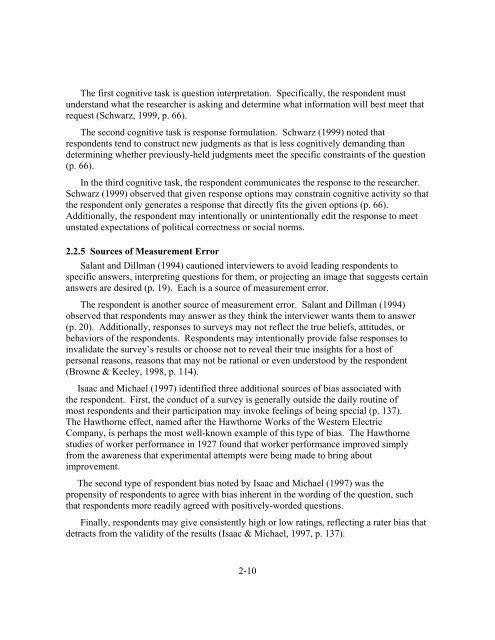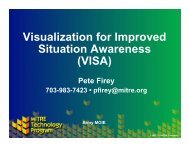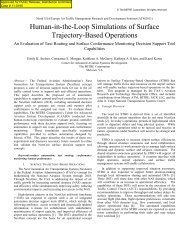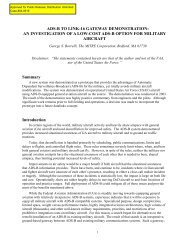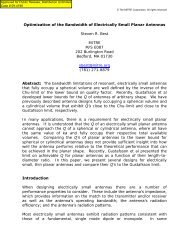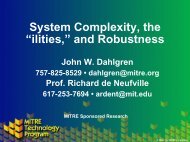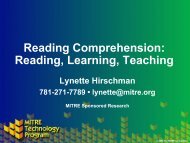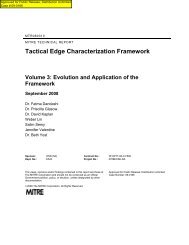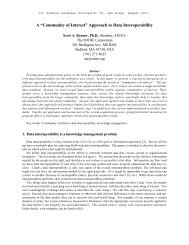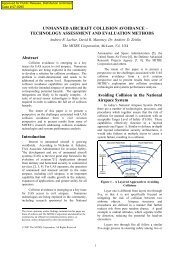Fundamentals of Survey Research Methodology - Mitre
Fundamentals of Survey Research Methodology - Mitre
Fundamentals of Survey Research Methodology - Mitre
Create successful ePaper yourself
Turn your PDF publications into a flip-book with our unique Google optimized e-Paper software.
The first cognitive task is question interpretation. Specifically, the respondent must<br />
understand what the researcher is asking and determine what information will best meet that<br />
request (Schwarz, 1999, p. 66).<br />
The second cognitive task is response formulation. Schwarz (1999) noted that<br />
respondents tend to construct new judgments as that is less cognitively demanding than<br />
determining whether previously-held judgments meet the specific constraints <strong>of</strong> the question<br />
(p. 66).<br />
In the third cognitive task, the respondent communicates the response to the researcher.<br />
Schwarz (1999) observed that given response options may constrain cognitive activity so that<br />
the respondent only generates a response that directly fits the given options (p. 66).<br />
Additionally, the respondent may intentionally or unintentionally edit the response to meet<br />
unstated expectations <strong>of</strong> political correctness or social norms.<br />
2.2.5 Sources <strong>of</strong> Measurement Error<br />
Salant and Dillman (1994) cautioned interviewers to avoid leading respondents to<br />
specific answers, interpreting questions for them, or projecting an image that suggests certain<br />
answers are desired (p. 19). Each is a source <strong>of</strong> measurement error.<br />
The respondent is another source <strong>of</strong> measurement error. Salant and Dillman (1994)<br />
observed that respondents may answer as they think the interviewer wants them to answer<br />
(p. 20). Additionally, responses to surveys may not reflect the true beliefs, attitudes, or<br />
behaviors <strong>of</strong> the respondents. Respondents may intentionally provide false responses to<br />
invalidate the survey’s results or choose not to reveal their true insights for a host <strong>of</strong><br />
personal reasons, reasons that may not be rational or even understood by the respondent<br />
(Browne & Keeley, 1998, p. 114).<br />
Isaac and Michael (1997) identified three additional sources <strong>of</strong> bias associated with<br />
the respondent. First, the conduct <strong>of</strong> a survey is generally outside the daily routine <strong>of</strong><br />
most respondents and their participation may invoke feelings <strong>of</strong> being special (p. 137).<br />
The Hawthorne effect, named after the Hawthorne Works <strong>of</strong> the Western Electric<br />
Company, is perhaps the most well-known example <strong>of</strong> this type <strong>of</strong> bias. The Hawthorne<br />
studies <strong>of</strong> worker performance in 1927 found that worker performance improved simply<br />
from the awareness that experimental attempts were being made to bring about<br />
improvement.<br />
The second type <strong>of</strong> respondent bias noted by Isaac and Michael (1997) was the<br />
propensity <strong>of</strong> respondents to agree with bias inherent in the wording <strong>of</strong> the question, such<br />
that respondents more readily agreed with positively-worded questions.<br />
Finally, respondents may give consistently high or low ratings, reflecting a rater bias that<br />
detracts from the validity <strong>of</strong> the results (Isaac & Michael, 1997, p. 137).<br />
2-10


